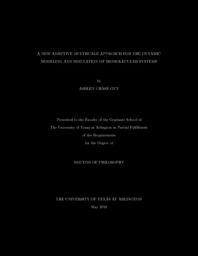
ATTENTION: The works hosted here are being migrated to a new repository that will consolidate resources, improve discoverability, and better show UTA's research impact on the global community. We will update authors as the migration progresses. Please see MavMatrix for more information.
Show simple item record
| dc.contributor.advisor | Bowling, Alan | |
| dc.creator | Guy, Ashley Chase | |
| dc.date.accessioned | 2023-09-11T15:12:11Z | |
| dc.date.available | 2023-09-11T15:12:11Z | |
| dc.date.created | 2018-05 | |
| dc.date.submitted | May 2018 | |
| dc.identifier.uri | http://hdl.handle.net/10106/31684 | |
| dc.description.abstract | This dissertation presents three developments in the simulation of sub-micron dynamical systems. First, a new thermostat formulation is shown to strictly enforce the constant temperature constraint necessary in many thermodynamic ensembles. This formulation also allows the system to quickly evolve to a low-potential state. Next, this new thermostat formulation is leveraged to extend a continuum-regime multiscale formulation to the atomistic regime allowing for equivalent time histories to be generated in significantly less computation time. Finally, an adaptive multiscale formulation allows for potential forces with time varying magnitudes to contribute to the overall dynamics similarly resulting in equivalent time histories in significantly less computation time.
Sub-micron dynamical simulations traditionally require extensive computational resources to generate desired time evolutions. Microscale phenomena are often driven by even smaller scale dynamics, requiring multiscale system definitions to combine these effects. At the smallest scale, large active forces lead to large resultant accelerations, requiring small integration time steps to fully capture the motion and dictating the integration time for the entire model. Multiscale modeling techniques aim to reduce this burdensome computational cost.
A multiscale method has been previously shown to greatly reduce the real time required to generate equivalent data. This method identifies a portion of the active and dissipative forces that cancel and contribute little to the overall motion. By scaling these forces, high-frequency vibrations are diminished without significantly affecting the time histories. Integration step sizes can then be increased, reducing the total number of required integration steps and reducing the real time required. This method has been previously applied to systems at length scales ranging from several hundred nanometers to large coarse grained organic molecules.
This multiscale method is first extended to the atomistic regime using a new thermostat formulation. Equivalent results were generated in significantly less time while maintaining the constant temperature constraint. Unlike previous multiscale formulations, this approach relies on a time-variant term to satisfy the multiscale analysis. This reliance on time-variant terms raised the question of how to reformulate the multiscale method to account for the changing proportions in the equations of motion.
The multiscale method was then extended to include an adaptive scaling consideration for forces whose magnitude changes significantly. This adaptive consideration accounts for instances in which certain small forces are not canceled. This consideration allows for small forces acting over long time periods to still produce significant results on the overall time history. Adaptively scaled results showed equivalent time histories to the unscaled case with computation time reduction consistent with previous works. | |
| dc.format.mimetype | application/pdf | |
| dc.language.iso | en_US | |
| dc.subject | Dynamics | |
| dc.subject | Multibody | |
| dc.subject | Multiscale | |
| dc.subject | Biopolymer | |
| dc.subject | Biomolecular | |
| dc.subject | Molecular Dynamics | |
| dc.title | A New Adaptive Multiscale Approach for the Dynamic Modeling and Simulation of Biomolecular Systems | |
| dc.type | Thesis | |
| dc.date.updated | 2023-09-11T15:12:11Z | |
| thesis.degree.department | Mechanical and Aerospace Engineering | |
| thesis.degree.grantor | The University of Texas at Arlington | |
| thesis.degree.level | Doctoral | |
| thesis.degree.name | Doctor of Philosophy in Mechanical Engineering | |
| dc.type.material | text | |
| dc.creator.orcid | 0000-0002-7045-6965 | |
Files in this item
- Name:
- GUY-DISSERTATION-2018.pdf
- Size:
- 4.965Mb
- Format:
- PDF
This item appears in the following Collection(s)
Show simple item record


